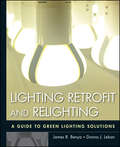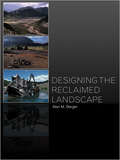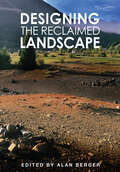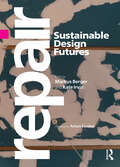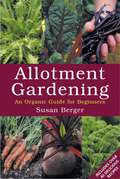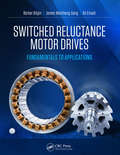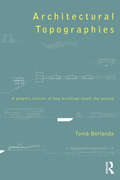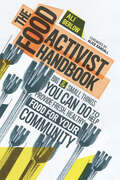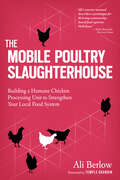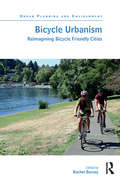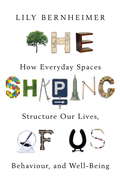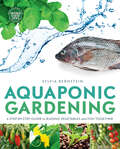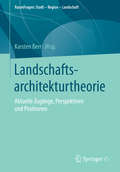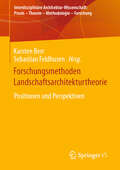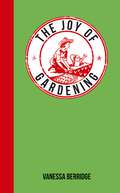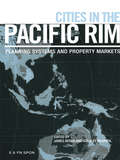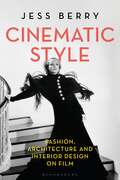- Table View
- List View
Urban Allotment Gardens in Europe
by Mary Benson Simon Bell Susan Noori Runrid Fox-Kämper Nazila Keshavarz Silvio Caputo Annette VoigtAlthough urban allotment gardening dates back to the nineteenth century, it has recently undergone a renaissance of interest and popularity. This is the result of greater concern over urban greenspace, food security and quality of life. This book presents a comprehensive, research-based overview of the various features, benefits and values associated with urban allotment gardening in Europe. The book is based on a European COST Action project, which brings together researchers and practitioners from all over Europe for the first detailed exploration of the subject on a continent-wide scale. It assesses the policy, planning and design aspects, as well as the social and ecological benefits of urban allotment gardening. Through an examination of the wide range of different traditions and practices across Europe, it brings together the most recent research to discuss the latest evolutions of urban allotment gardening and to help raise awareness and fill knowledge gaps. The book provides a multidisciplinary perspective, including insights from horticulture and soil science, ecology, sociology, urban geography, landscape, planning and design. The themes are underpinned by case studies from a number of European countries which supply a wide range of examples to illustrate different key issues.
Urban Allotment Gardens in Europe
by Mary Benson Simon Bell Susan Noori Runrid Fox-Kämper Nazila Keshavarz Silvio Caputo Annette VoigtAlthough urban allotment gardening dates back to the nineteenth century, it has recently undergone a renaissance of interest and popularity. This is the result of greater concern over urban greenspace, food security and quality of life. This book presents a comprehensive, research-based overview of the various features, benefits and values associated with urban allotment gardening in Europe. The book is based on a European COST Action project, which brings together researchers and practitioners from all over Europe for the first detailed exploration of the subject on a continent-wide scale. It assesses the policy, planning and design aspects, as well as the social and ecological benefits of urban allotment gardening. Through an examination of the wide range of different traditions and practices across Europe, it brings together the most recent research to discuss the latest evolutions of urban allotment gardening and to help raise awareness and fill knowledge gaps. The book provides a multidisciplinary perspective, including insights from horticulture and soil science, ecology, sociology, urban geography, landscape, planning and design. The themes are underpinned by case studies from a number of European countries which supply a wide range of examples to illustrate different key issues.
Lighting Retrofit and Relighting: A Guide to Energy Efficient Lighting
by James R. Benya Donna J. LebanThe ultimate guide to the retrofitting of lighting for greater efficiency and performance Retrofitting outdated energy-guzzling lighting components with green energy-saving alternatives is a process that promotes sustainability and offers significant benefits for businesses, contractors, and the community at large. Not only can retrofitting improve the overall quality and functionality of light, it also can make spaces safer, easier and less costly to maintain, and more comfortable to inhabit. From lighting technology to retrofit financial analysis, Lighting Retrofit and Relighting evaluates the latest lighting system types, then demonstrates how to apply them for the greatest functional and cost-saving benefit. This book: Discusses the recent advances in lighting equipment and retrofittable controls, for both interior and outdoor use Explains how to do a lighting audit to identify and evaluate logical retrofit choices Includes case studies of retrofits, illustrating improvements in the quality and efficacy of new lighting Demonstrates how cost savings realized over time can not only pay for new equipment but produce a return on the investment Lighting Retrofit and Relighting serves as an ideal reference for students or professionals—whether they are energy auditors, designers, installers, facilities managers, or manufacturers—by taking a close look at the most current lighting technology illuminating pathways toward a brighter future.
Lighting Retrofit and Relighting: A Guide to Energy Efficient Lighting
by James R. Benya Donna J. LebanThe ultimate guide to the retrofitting of lighting for greater efficiency and performance Retrofitting outdated energy-guzzling lighting components with green energy-saving alternatives is a process that promotes sustainability and offers significant benefits for businesses, contractors, and the community at large. Not only can retrofitting improve the overall quality and functionality of light, it also can make spaces safer, easier and less costly to maintain, and more comfortable to inhabit. From lighting technology to retrofit financial analysis, Lighting Retrofit and Relighting evaluates the latest lighting system types, then demonstrates how to apply them for the greatest functional and cost-saving benefit. This book: Discusses the recent advances in lighting equipment and retrofittable controls, for both interior and outdoor use Explains how to do a lighting audit to identify and evaluate logical retrofit choices Includes case studies of retrofits, illustrating improvements in the quality and efficacy of new lighting Demonstrates how cost savings realized over time can not only pay for new equipment but produce a return on the investment Lighting Retrofit and Relighting serves as an ideal reference for students or professionals—whether they are energy auditors, designers, installers, facilities managers, or manufacturers—by taking a close look at the most current lighting technology illuminating pathways toward a brighter future.
Designing the Reclaimed Landscape
by Alan BergerThe first practical yet in-depth exploration of how to reclaim the post-industrial landscape, this volume includes excellent case studies by practitioners and policy makers from around the US, giving first rate practical examples. The book addresses new thinking about landscape, which applies new techniques to the task of transforming outdated and disused post-extraction landscapes through design. In the USA alone, there are nearly 500,000 abandoned mines in need of reclamation and this book provides the first in-depth guidance on this real and pressing issue. Drawing on the work of the well-known Project for Reclamation Excellence at Harvard's Graduate School of Design, this volume outlines the latest design thinking, theory and practice for landscape planners, landscape architects and designers and others interested in maximizing the future potential of reclaimed land.
Designing the Reclaimed Landscape
by Alan BergerThe first practical yet in-depth exploration of how to reclaim the post-industrial landscape, this volume includes excellent case studies by practitioners and policy makers from around the US, giving first rate practical examples. The book addresses new thinking about landscape, which applies new techniques to the task of transforming outdated and disused post-extraction landscapes through design. In the USA alone, there are nearly 500,000 abandoned mines in need of reclamation and this book provides the first in-depth guidance on this real and pressing issue. Drawing on the work of the well-known Project for Reclamation Excellence at Harvard's Graduate School of Design, this volume outlines the latest design thinking, theory and practice for landscape planners, landscape architects and designers and others interested in maximizing the future potential of reclaimed land.
Repair: Sustainable Design Futures
by Markus Berger Kate IrvinA collection of timely new scholarship, Repair: Sustainable Design Futures investigates repair as a contemporary expression of empowerment, agency, and resistance to our unmaking of the world and the environment. Repair is an act, metaphor, and foundation for opening up a dialogue about design’s role in proposing radically different social, environmental, and economic futures. Thematically expansive and richly illustrated, with over 125 visuals, this volume features an international, interdisciplinary group of contributors from across the design spectrum whose voices and artwork speak to how we might address our broken social and physical worlds. Organized around reparative thinking and practices, the book includes 30 long and short chapters, photo essays, and interviews that focus on multiple responses to fractured systems, relationships, cities, architecture, objects, and more. Repair will encourage students, academics, researchers, and practitioners in art, design and architecture practice and theory, cultural studies, environment and sustainability, to discuss, engage, and rethink the act of repair and its impact on our society and environment.
Repair: Sustainable Design Futures
by Markus Berger Kate IrvinA collection of timely new scholarship, Repair: Sustainable Design Futures investigates repair as a contemporary expression of empowerment, agency, and resistance to our unmaking of the world and the environment. Repair is an act, metaphor, and foundation for opening up a dialogue about design’s role in proposing radically different social, environmental, and economic futures. Thematically expansive and richly illustrated, with over 125 visuals, this volume features an international, interdisciplinary group of contributors from across the design spectrum whose voices and artwork speak to how we might address our broken social and physical worlds. Organized around reparative thinking and practices, the book includes 30 long and short chapters, photo essays, and interviews that focus on multiple responses to fractured systems, relationships, cities, architecture, objects, and more. Repair will encourage students, academics, researchers, and practitioners in art, design and architecture practice and theory, cultural studies, environment and sustainability, to discuss, engage, and rethink the act of repair and its impact on our society and environment.
Allotment Gardening: An Organic Guide for Beginners
by Susan BergerGrow your own organic fruit and vegetables with this practical guide to setting up and maintaining an allotment garden.Allotments provide a wonderful opportunity to connect with nature and become more self-sufficient, growing fresh produce to cook with. But getting started on your plot can sometimes feel a bit daunting. Written by garden designer Susan Berger and illustrated throughout with drawings and photographs, Allotment Gardening is packed with advice on growing and maintaining your allotment garden – from choosing and planning your allotment through to harvesting and storing your produce. The first half of this handy guide discusses allotment basics, such as what tools to buy and how to plan and clear your site. Susan then shares useful information on crop rotation, planting and how to protect plants against pests and harsh weather. She also looks at design and growing techniques, including feeding plants, mulching, saving seeds and supporting plants, and how to prevent and cope with common problems. The second half of the book focuses on the cultivation of individual fruit, vegetables, flowers and herbs, along with recommendations for particular varieties chosen for their flavour, and ideas for companion planting. There are detailed instructions on how to store produce efficiently, as well as tips on herb usage. Each fruit and vegetable entry features an easy recipe to help you make the most of your fresh produce, such as pea soup, Frizzled Brussels Sprouts, Sautéed Kohl Rabi, jam and pudding. Ideal for beginner gardeners growing on their first site, Allotment Gardening also includes a gardener's calendar with monthly activities, and a directory of seed suppliers and useful organisations.
Switched Reluctance Motor Drives: Fundamentals to Applications
by Berker Bilgin, James Weisheng Jiang and Ali EmadiElectric motors are the largest consumer of electric energy and they play a critical role in the growing market for electrification. Due to their simple construction, switched reluctance motors (SRMs) are exceptionally attractive for the industry to respond to the increasing demand for high-efficiency, high-performance, and low-cost electric motors with a more secure supply chain. Switched Reluctance Motor Drives: Fundamentals to Applications is a comprehensive textbook covering the major aspects of switched reluctance motor drives. It provides an overview of the use of electric motors in the industrial, residential, commercial, and transportation sectors. It explains the theory behind the operation of switched reluctance motors and provides models to analyze them. The book extensively concentrates on the fundamentals and applications of SRM design and covers various design details, such as materials, mechanical construction, and controls. Acoustic noise and vibration is the most well-known issue in switched reluctance motors, but this can be reduced significantly through a multidisciplinary approach. These methodologies are explained in two chapters of the book. The first covers the fundamentals of acoustic noise and vibration so readers have the necessary tools to analyze the problems and explains the surface waves, spring-mass models, forcing harmonics, and mode shapes that are utilized in modeling and analyzing acoustic noise and vibration. The second applies these fundamentals to switched reluctance motors and provides examples for determining the sources of any acoustic noise in switched reluctance motors. In the final chapter two SRM designs are presented and proposed as replacements for permanent magnet machines in a residential HVAC application and a hybrid-electric propulsion application. It also shows a high-power and compact converter design for SRM drives. Features: Comprehensive coverage of switched reluctance motor drives from fundamental principles to design, operation, and applications A specific chapter on electric motor usage in industrial, residential, commercial, and transportation applications to address the benefits of switched reluctance machines Two chapters address acoustic noise and vibration in detail Numerous illustrations and practical examples on the design, modeling, and analysis of switched reluctance motor drives Examples of switched reluctance motor and drive design
Architectural Topographies: A Graphic Lexicon of How Buildings Touch the Ground
by Tomà BerlandaArchitectural Topographies is a critical dictionary for architects and landscape architects in which the graphic lexicon can be read from a beginning, the ground, to a conclusion, the specific case studies. Meant as a tool to help you recognise, analyse, choose, and invent solutions, the book's key words refer to the physical and material relationship between construction and ground; to where and how the link is built; to the criteria, methods, and tools used to know and transform the ground; and to the possible approaches to the place and their implications on the way the earth is touched. Fifty case studies by forty-six of the greatest architects of the previous hundred years are represented throughout in sectional drawings which place the buildings along the same ground plane to illustrate how the key words might be combined and to show each architect's position on their built work in relation to all the others. Includes projects by Alvar Aalto; Tadao Ando; Gunnar Asplund; Atelier Bow-Wow; João Batista Vilanova Artigas; Patrick Berger; Mario Botta; Marcel Breuer; Erik Bryggman; Gonçalo Byrne; David Chipperfield; Le Corbusier; Sverre Fehn; Aurelio Galfetti, Flora Ruchat, and Ivo Trumpy; Dick Van Gameren; Herzog and De Meuron; Steven Holl; Arne Jacobsen; Kengo Kuma; Anne Lacaton and Jean Philippe Vassal; Adalberto Libera; Frank Lloyd Wright; Paulo Mendes da Rocha; Ludwig Mies van der Rohe; Enric Miralles and Carme Pinos; Glenn Murcutt; Juan Navarro Baldeweg; Sheila O’Donnell and John Tuomey; Jan Olav Jensen and Børre Skodvin; John Pawson; Giuseppe Perugini, Mario Fiorentino, and Nello Aprile; Renzo Piano; Georges-Henry Pingusson; Rudolph Schindler; Roland Simounet; Alvaro Siza; Luigi Snozzi; Alejandro de la Sota; Eduardo Souto de Moura; Alison Smithson and Peter Smithson; Fernando Tavora; Jørn Utzon; Livio Vacchini; Francesco Venezia, Roberto Collovà, and Marcella Aprile; Amancho Williams; and Peter Zumthor.
Architectural Topographies: A Graphic Lexicon of How Buildings Touch the Ground
by Tomà BerlandaArchitectural Topographies is a critical dictionary for architects and landscape architects in which the graphic lexicon can be read from a beginning, the ground, to a conclusion, the specific case studies. Meant as a tool to help you recognise, analyse, choose, and invent solutions, the book's key words refer to the physical and material relationship between construction and ground; to where and how the link is built; to the criteria, methods, and tools used to know and transform the ground; and to the possible approaches to the place and their implications on the way the earth is touched. Fifty case studies by forty-six of the greatest architects of the previous hundred years are represented throughout in sectional drawings which place the buildings along the same ground plane to illustrate how the key words might be combined and to show each architect's position on their built work in relation to all the others. Includes projects by Alvar Aalto; Tadao Ando; Gunnar Asplund; Atelier Bow-Wow; João Batista Vilanova Artigas; Patrick Berger; Mario Botta; Marcel Breuer; Erik Bryggman; Gonçalo Byrne; David Chipperfield; Le Corbusier; Sverre Fehn; Aurelio Galfetti, Flora Ruchat, and Ivo Trumpy; Dick Van Gameren; Herzog and De Meuron; Steven Holl; Arne Jacobsen; Kengo Kuma; Anne Lacaton and Jean Philippe Vassal; Adalberto Libera; Frank Lloyd Wright; Paulo Mendes da Rocha; Ludwig Mies van der Rohe; Enric Miralles and Carme Pinos; Glenn Murcutt; Juan Navarro Baldeweg; Sheila O’Donnell and John Tuomey; Jan Olav Jensen and Børre Skodvin; John Pawson; Giuseppe Perugini, Mario Fiorentino, and Nello Aprile; Renzo Piano; Georges-Henry Pingusson; Rudolph Schindler; Roland Simounet; Alvaro Siza; Luigi Snozzi; Alejandro de la Sota; Eduardo Souto de Moura; Alison Smithson and Peter Smithson; Fernando Tavora; Jørn Utzon; Livio Vacchini; Francesco Venezia, Roberto Collovà, and Marcella Aprile; Amancho Williams; and Peter Zumthor.
The Food Activist Handbook: Big & Small Things You Can Do to Help Provide Fresh, Healthy Food for Your Community
by Ali BerlowA valuable guide packed with practical ways you can support your local food community and create access to healthy food for everyone.
The Mobile Poultry Slaughterhouse: Building a Humane Chicken-Processing Unit to Strengthen Your Local Food System
by Ali BerlowAli Berlow offers a step-by-step guide to building a mobile poultry slaughterhouse that can serve communities and small farmers.
Bicycle Urbanism: Reimagining Bicycle Friendly Cities (Urban Planning and Environment)
by Rachel BerneyOver recent decades, bicycling has received renewed interest as a means of improving transportation through crowded cities, improving personal health, and reducing environmental impacts associated with travel. Much of the discussion surrounding cycling has focused on bicycle facility design—how to best repurpose road infrastructure to accommodate bicycling. While part of the discussion has touched on culture, such as how to make bicycling a larger part of daily life, city design and planning have been sorely missing from consideration. Whilst interdisciplinary in its scope, this book takes a primarily planning approach to examining active transportation, and especially bicycling, in urban areas. The volume examines the land use aspects of the city—not just the streetscape. Illustrated using a range of case studies from the USA, Canada, and Australia, the volume provides a comprehensive overview of key topics of concern around cycling in the city including: imagining the future of bicycle-friendly cities; integrating bicycling into urban planning and design; the effects of bike use on health and environment; policies for developing bicycle infrastructure and programs; best practices in bicycle facility design and implementation; advances in technology, and economic contributions.
Bicycle Urbanism: Reimagining Bicycle Friendly Cities (Urban Planning and Environment)
by Rachel BerneyOver recent decades, bicycling has received renewed interest as a means of improving transportation through crowded cities, improving personal health, and reducing environmental impacts associated with travel. Much of the discussion surrounding cycling has focused on bicycle facility design—how to best repurpose road infrastructure to accommodate bicycling. While part of the discussion has touched on culture, such as how to make bicycling a larger part of daily life, city design and planning have been sorely missing from consideration. Whilst interdisciplinary in its scope, this book takes a primarily planning approach to examining active transportation, and especially bicycling, in urban areas. The volume examines the land use aspects of the city—not just the streetscape. Illustrated using a range of case studies from the USA, Canada, and Australia, the volume provides a comprehensive overview of key topics of concern around cycling in the city including: imagining the future of bicycle-friendly cities; integrating bicycling into urban planning and design; the effects of bike use on health and environment; policies for developing bicycle infrastructure and programs; best practices in bicycle facility design and implementation; advances in technology, and economic contributions.
The Shaping of Us: How Everyday Spaces Structure our Lives, Behaviour, and Well-Being
by Lily Bernheimer"You are going to be transported by what Bernheimer has to say. You'll make different decisions and figure out how your brain is working and what should be prioritized in your life" Jo Good, BBC LondonWhat makes everyday spaces work, how do they shape us, and what do they say about us?The spaces we live in - whether public areas, housing, offices, hospitals, or cities - mediate community, creativity, and our very identity, making us who we are. Using insights from environmental psychology, design, and architecture, The Shaping of Us reveals the often imperceptible ways in which our surroundings influence our behaviour.Wide-ranging and global examples cover the differences between personalities and nationalities, explore grass-roots and mainstream efforts to build environments promoting well-being, and look ahead to what will become of us if we don't listen closely to what we know is good for us.You will learn whether you are a natural 'prospector' or 'refuger' in the office environment, what roundabouts and stoplights say about British and American culture, whether you are guilty of NIMBYism or being drawn to 'ruin porn', and how the half-house may be a common sight in the near future.The environments we inhabit define our identities - from the earliest moments of our evolution to the worlds we build around ourselves.
Aquaponic Gardening: A Step-by-step Guide to Raising Vegetables and Fish Together
by Sylvia Bernstein"The one source that will guide you from start to finish" (Gina Cavaliero, Aquaponi Inc) Aquaponi is a revolutionary way of gardening by combining the best of aquaculture and hydroponi. It is an amazingly fun and easy way to grow organic fruit and vegetables by simply fertilising them with waste water from fish. Aquaponic systems are completely organic, hugely productive and there's no weeding, watering, bending or digging. This is the definitive do-it-yourself manual giving you all the tools you need to create your own aquaponic system and enjoy fresh and healthy food all year round.
Landschaftsarchitekturtheorie: Aktuelle Zugänge, Perspektiven und Positionen (RaumFragen: Stadt – Region – Landschaft)
by Karsten BerrDie Beiträge dieses Bandes untersuchen den Sinn und Zweck der Praxis von Landschaftsarchitekten, die bei der Gestaltung einer bewohnbaren Welt eine bedeutsame Rolle spielen. Diese Praxis ist in lebensweltliche, kulturelle und soziale Rahmenbedingungen eingebunden. Theorie hat zum einen dieser soziokulturellen Eingebundenheit der Praxis Rechnung zu tragen. Theorie hat sich aber auch auf ihren wissenschaftstheoretischen Status innerhalb der Wissenschaften und Disziplinen zu beziehen, um eine unnötige praxisferne Verwissenschaftlichung zu vermeiden. Insofern reflektiert die Landschaftsarchitekturtheorie die Bedingungen ihres eigenen Gelingens wie auch die Bedingungen für gelingende Praxis. Die Beiträge dieses Bandes tragen zum besseren Verständnis von Praxis wie Theorie für die Praxis der Landschaftsarchitektur bei.Der HerausgeberDr. Karsten Berr ist an der Universität Vechta tätig.
Forschungsmethoden Landschaftsarchitekturtheorie: Positionen und Perspektiven (Interdisziplinäre Architektur-Wissenschaft: Praxis – Theorie – Methodologie – Forschung)
by Karsten Berr Sebastian FeldhusenWie werden in Forschungsarbeiten in der Landschaftsarchitekturtheorie Erkenntnisse gewonnen? Um diese Frage zu beantworten, ist es sinnvoll, die Methode der Forschung einer individuellen Forschungsarbeit anschaulich zu machen. Ziel des Buchs ist es, eine Übersicht an aktuellen Forschungsmethoden im Feld der Landschaftsarchitekturtheorie zu geben. Damit möchte das Buch einen Beitrag zur Methodendiskussion in der Landschaftsarchitekturtheorie leisten, die häufig gefordert, aber selten geführt wird. Die Aufsätze in dem Buch sind untereinander formal und inhaltlich abgestimmt: Formal haben sie einen ähnlichen Aufbau, sodass die Methoden gut miteinander verglichen werden können. Inhaltlich sind die Aufsätze insofern miteinander abgestimmt, weil jeder Aufsatz für eine bestimmte Forschungsmethode in der Landschaftsarchitekturtheorie steht.
The Joy of Gardening (The\joy Of Ser.)
by Vanessa BerridgeThis pocket-sized miscellany, packed with quirky facts, quotes, handy hints and surprising stories is the perfect pick-me-up for anyone who knows the incomparable joy of gardening.
Cities in the Pacific Rim
by James Berry Stanley McGrealThe cities of the Pacific Rim are in one of the most dynamic spheres of the global economy. In the twenty first century the focus of global affairs is destined to shift from the West to the East. These cities offer a wide range of different responses to the demands that rapid growth puts on planning and infrastructure : from the laxity that has lead to the urban sprawl of Bangkok to the regulation that is characteristic of Singapore. This book considers the interactive relationships between the operation of the planning system and the role and performance of property development and real estate markets in 14 Pacific Rim cities drawn from both the Eastern and Western perspective. The dynamic underlying these relationships considers the interplay between administrative structures, legislative controls and policy issues examining the role of actors and agencies in the property development and investment process.
Cities in the Pacific Rim: Planning Systems And Property Markets
by James Berry Stanley McGrealThe cities of the Pacific Rim are in one of the most dynamic spheres of the global economy. In the twenty first century the focus of global affairs is destined to shift from the West to the East. These cities offer a wide range of different responses to the demands that rapid growth puts on planning and infrastructure : from the laxity that has lead to the urban sprawl of Bangkok to the regulation that is characteristic of Singapore. This book considers the interactive relationships between the operation of the planning system and the role and performance of property development and real estate markets in 14 Pacific Rim cities drawn from both the Eastern and Western perspective. The dynamic underlying these relationships considers the interplay between administrative structures, legislative controls and policy issues examining the role of actors and agencies in the property development and investment process.
Cinematic Style: Fashion, Architecture and Interior Design on Film
by Jess BerryFrom cinema's silent beginnings, fashion and interior design have been vital to character development and narrative structure. Despite spectacular technological advancements on screen, stunning silhouettes and striking spaces still have the ability to dazzle to dramatic effect. This book is the first to consider the significant interplay between fashion and interiors and their combined contribution to cinematic style from early film to the digital age.With examples from Frank Lloyd Wright inspired architecture in Hitchcock's North by Northwest, to Coco Chanel's costumes for Gloria Swanson and a Great Gatsby film-set turned Ralph Lauren flagship, Cinematic Style describes the reciprocal relationship between these cultural forms. Exposing the bleeding lines between fashion and interiors in cinematic and real-life contexts, Berry presents case studies of cinematic styles adopted as brand identities and design movements promoted through filmic fantasy.Shedding light on consumer culture, social history and gender politics as well as on fashion, film and interior design theory, Cinematic Style considers the leading roles domestic spaces, quaint cafes, little black dresses and sharp suits have played in 20th and 21st-century film.
Cinematic Style: Fashion, Architecture and Interior Design on Film
by Jess BerryFrom cinema's silent beginnings, fashion and interior design have been vital to character development and narrative structure. Despite spectacular technological advancements on screen, stunning silhouettes and striking spaces still have the ability to dazzle to dramatic effect. This book is the first to consider the significant interplay between fashion and interiors and their combined contribution to cinematic style from early film to the digital age.With examples from Frank Lloyd Wright inspired architecture in Hitchcock's North by Northwest, to Coco Chanel's costumes for Gloria Swanson and a Great Gatsby film-set turned Ralph Lauren flagship, Cinematic Style describes the reciprocal relationship between these cultural forms. Exposing the bleeding lines between fashion and interiors in cinematic and real-life contexts, Berry presents case studies of cinematic styles adopted as brand identities and design movements promoted through filmic fantasy.Shedding light on consumer culture, social history and gender politics as well as on fashion, film and interior design theory, Cinematic Style considers the leading roles domestic spaces, quaint cafes, little black dresses and sharp suits have played in 20th and 21st-century film.

